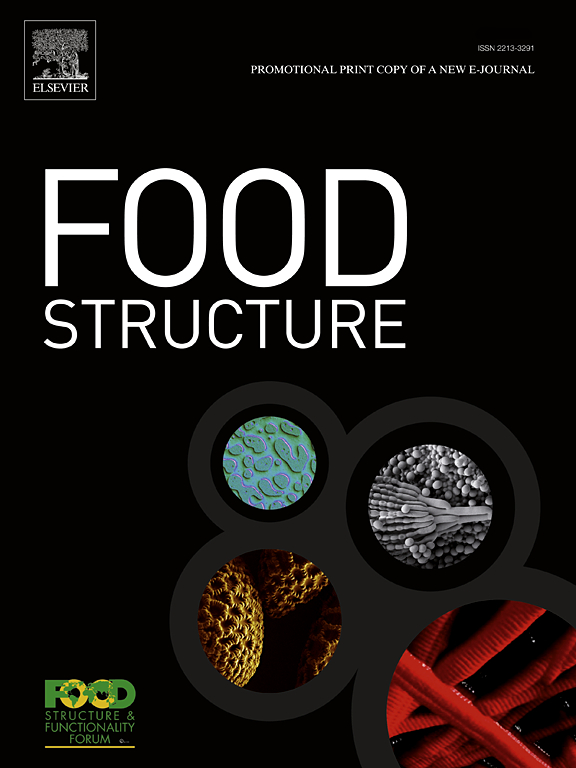含有富含蛋白质的小麦和燕麦面粉水提取物的发酵麸质淀粉模型面团的时间分辨x射线微计算机断层扫描研究
IF 5.9
3区 农林科学
Q1 FOOD SCIENCE & TECHNOLOGY
引用次数: 0
摘要
水萃取谷物面粉成分显著影响面包的体积。然而,潜在的机制和不同成分的贡献仍不清楚。本研究利用时间分辨x射线微计算机断层扫描(µCT)和激光共聚焦扫描显微镜研究了小麦和燕麦面粉水提物在发酵过程中对模型麸质淀粉(GS)面团中气体细胞和面团链演变的影响。总的来说,在发酵的前40 分钟内,观察到气体细胞数量大幅减少,伴随着气体细胞合并和歧化的视觉证据,表明早期气体细胞不稳定,与现有文献相反。添加WE小麦粉蛋白增加了烘春期间的面团高度,提高了GS面包的比容。由于这并没有伴随着气泡大小分布的变化,因此我们假设添加WE小麦粉蛋白质对面包的积极响应是由于在烤箱弹簧过程中液体薄膜和/或气泡面团界面的稳定。相比之下,加入WE燕麦面粉蛋白会降低打样和烤箱弹簧后的面团高度,导致GS面包的比容降低43% %。这与混合后和发酵过程中x射线微CT图像中观察到的更不均匀的气细胞大小分布有关,这是由面团应变硬化能力差引起的。这项研究为谷物面粉中WE蛋白在调节面包面团多孔结构中的作用提供了新的机制见解。本文章由计算机程序翻译,如有差异,请以英文原文为准。
A time-resolved X-ray microcomputed tomography study of fermenting gluten-starch model doughs containing wheat and oat flour water extracts enriched in proteins
Water-extractable (WE) cereal flour constituents significantly influence bread loaf volume. However, the underlying mechanisms and the contribution of different constituents remain unclear. Here, time-resolved X-ray microcomputed tomography (µCT) and confocal laser scanning microscopy were utilized to study the impact of wheat and oat flour water extracts enriched in proteins on the evolution of gas cells and dough strands in model gluten-starch (GS) dough during fermentation. Overall, a substantial decrease in gas cell count within the first 40 min of fermentation was observed, accompanied by visual evidence of gas cell coalescence and disproportionation, indicating early-stage gas cell destabilization, contrary to existing literature. The addition of WE wheat flour proteins increased dough height during oven spring and enhanced the specific volume of GS bread. As this was not accompanied by changes in the evolution of the gas cell size distribution, the positive bread response due to WE wheat flour protein addition was hypothesized to be due to the stabilization of the thin liquid film and/or gas cell-dough interfaces during oven spring. Contrastingly, incorporating WE oat flour proteins decreased dough height after proofing and oven spring, resulting in GS bread with a 43 % lower specific volume. This was linked to a much more heterogeneous gas cell size distribution observed in X-ray µCT images immediately after mixing and during fermentation, caused by the poor strain hardening capacity of the dough. This study provides new mechanistic insights into the role of WE proteins from cereal flours in modulating the porous structure of bread dough.
求助全文
通过发布文献求助,成功后即可免费获取论文全文。
去求助
来源期刊

Food Structure-Netherlands
Chemical Engineering-Bioengineering
CiteScore
7.20
自引率
0.00%
发文量
48
期刊介绍:
Food Structure is the premier international forum devoted to the publication of high-quality original research on food structure. The focus of this journal is on food structure in the context of its relationship with molecular composition, processing and macroscopic properties (e.g., shelf stability, sensory properties, etc.). Manuscripts that only report qualitative findings and micrographs and that lack sound hypothesis-driven, quantitative structure-function research are not accepted. Significance of the research findings for the food science community and/or industry must also be highlighted.
 求助内容:
求助内容: 应助结果提醒方式:
应助结果提醒方式:


